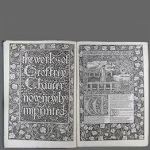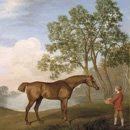

This museum experience took place on Saturday, November 30th 2008 at the Yale Center for British Art in New Haven, Connecticut. I visited this museum on the same day as the Yale University Art Gallery. As stated before in my other paper on the art gallery, it was as if I traveled around the world and through time in one day. While at this museum, my daughter and I were immersed in the art and culture of British society from the Elizabethan period onward.
The Yale Center for British Art has the largest collection of British art outside of the United Kingdom.[1] It was founded by well known philanthropist Paul Mellon, a Yale graduate who donated thousands of paintings and drawings from his own private collection that spanned several decades. [2] He and his family also provided funds for the construction of the National Gallery of Art in Washington, D.C., in addition to paintings from his own personal collection. [3] Today, this Yale museum houses an extensive collection of paintings, drawings, rare books and manuscripts, as well as sponsors a host of academic, scholarly, and cultural opportunities. [4]
One of the museum’s many highlights is the magnificent building that houses all of the amazing works of art. It was designed and completed by world-renowned architect, Louis I. Kahn in 1974.[5] This facility is made of steel beams and reflective glass, which gives the visitor the sense of “intimate galleries and the ability to view works in natural light.” [6] The museum only turns artificial light on days in which it is cloudy or at night.[7] In turn, each person gets to see the piece as it might have been seen by the artist or the patron for which the painting or drawing was made for.
There are four main permanent collections within the museum: paintings and sculptures, prints and drawings, rare books and manuscripts, and the library and photo archive. Each houses a variety of different types of art. The painting and sculpture exhibit includes about 2,000 paintings and 100 sculptures depicting British life from the end of the Middle Ages up through the present time.[8] Types of paintings include large portraits, landscape drawings, travel paintings of India and Pakistan, and scenes from Shakespearean plays. [9] One of the first British paintings Paul Mellon purchased was entitled “Pumpkin with a stable lad” by George Stubbs, a famous 18th century painter. [10] Other artists who are represented in this collection include John Constable and sculptors Stanley Spencer and Damien Hirst, to name a few. This was my favorite part of the museum. I was intrigued by the dimension, style, and stateliness of the paintings, especially the portraits. It felt as if the subject’s eyes followed you throughout your visit. This made me feel as if I was transported back to the time that the painting was created and could feel exactly what the individual felt as he or she sat for their portrait.
The prints and drawings collection includes about 50,000 examples of both watercolors and prints. [11] It highlights the development of British Graphic art and the British watercolor school in the late 18th and early 19th centuries. [12] Other areas of interest include architecture and caricatures, as well as characters from Shakespeare’s plays. One of my favorite watercolors is by J.M.W. Turner which is called “Steamboat in Storm.” I like this painting because of the contrast in colors used, as well as the in which the artist painted the clouds in the sky, which looks as if it is opening up to swallow the sea hole. On the other hand, I was also impressed by a black and white print by David Lucas, called “The Rainbow, Salisbury Cathedral,” because of the beautiful rainbow that extends over the church. It serves as a symbol of God’s enduring promise for peace and is shown beautifully by the contrast between the light and the dark ink, which only adds to its brilliance.
Even though I did not have a chance to see the other two departments within the museum, it is worth noting each one’s significance. For instance, the rare books and manuscripts collection includes about 30,000 titles, with some dating back to the 1600’s.[13] It is known for its array of illustrated “color-plate” books, which include sporting books, maps, atlases, art, and artists.[14] Also, they have a non-circulating reference library and photo archive that includes a myriad of books, publications, journals, and over 200,000 black and white photos of British artwork from around the world. [15]
Overall, my experience at the Yale Center for British Art was very enjoyable and quite intellectually and emotionally stimulating. I had been here once before with my daughter and we were both impressed the first time we went. Having a chance to go back again was wonderful because it gave me a chance to see things that I missed, as well as focus on pieces that caught my eye the first time. I would highly recommend this museum to anyone who wishes to gain a better understanding of British history and to see a world-class art museum that is so close to home.
[1] http://ycba.yale.edu/info/index.html
[2] Ibid.
[3] Ibid.
[4] Ibid.
[5] http://www.ycba.yale.edu/information/info_architecture.html
[6] Ibid.
[7] Ibid.
[8] http://www.ycba.yale.edu/collections/coll_p-s%20index..html
[9] Ibid.
[10] Ibid.
[11] Ibid.
[12] Ibid.
[13] http://www.ycba.yale.edu/collections/coll_rb-m-index.html
[14] Ibid.
[15] http://www.ycba.yale.edu/collections/coll_library-index.html
[1] http://ycba.yale.edu/info/index.html
[2] Ibid.
[3] Ibid.
[4] Ibid.
[5] http://www.ycba.yale.edu/information/info_architecture.html
[6] Ibid.
[7] Ibid.
[8] http://www.ycba.yale.edu/collections/coll_p-s%20index..html
[9] Ibid.
[10] Ibid.
[11] Ibid.
[12] Ibid.
[13] http://www.ycba.yale.edu/collections/coll_rb-m-index.html
[14] Ibid.
[15] http://www.ycba.yale.edu/collections/coll_library-index.html






No comments:
Post a Comment